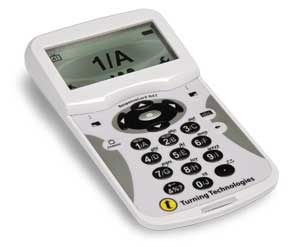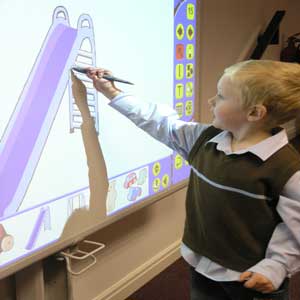Using Clickers in the Classroom
Student response systems (“clickers”) are popular in the classroom, and we know that kids enjoy using them. But do they really enhance learning?
 Clickers enable electronic voting, described as a “game-based” approach for gathering student feedback. Kids can weigh in anonymously, and teachers benefit by hearing from the entire class. In this way, student response systems serve as a form of assessment that can help in planning instruction. In addition, students using clickers are actively participating (rather than just sitting and passively listening), which we know leads to better engagement and learning. One more advantage of student response systems is elimination of common pitfalls of typical class discussion—a few students dominate the conversation, or shy and lower-achieving students are hesitant to join in.
Clickers enable electronic voting, described as a “game-based” approach for gathering student feedback. Kids can weigh in anonymously, and teachers benefit by hearing from the entire class. In this way, student response systems serve as a form of assessment that can help in planning instruction. In addition, students using clickers are actively participating (rather than just sitting and passively listening), which we know leads to better engagement and learning. One more advantage of student response systems is elimination of common pitfalls of typical class discussion—a few students dominate the conversation, or shy and lower-achieving students are hesitant to join in.
Interactive Whiteboards;
Creative Uses for Interactive Whiteboards
What was once a novelty enjoyed by a handful of classrooms has become a fairly common educational tool. Yet despite students’ and teachers’ growing familiarity with interactive whiteboards, many seek usage ideas that go beyond the typical “animate a lesson.”
 Explore the following tips for getting the most out of your interactive whiteboard. While these general suggestions apply to popular brands such as Prometheus and SMART, remember to consult your operator’s manual for specific instructions.
Explore the following tips for getting the most out of your interactive whiteboard. While these general suggestions apply to popular brands such as Prometheus and SMART, remember to consult your operator’s manual for specific instructions.
Use Your Board’s “Record” Function to Archive Lessons
Most interactive whiteboard models come with software that allows users to create presentations as well as take notes in a blank file. During an open discussion, jot down notes or key points in a blank board file, just as you would on a traditional whiteboard. Save at the end of the discussion, and you’ll have everything you’ve covered, including student contributions, all in one digital file.
This is handy for many reasons. In the short term, you can publish the file to your Web site, or print it out and let students use it to prepare for a test. Either way, students who were absent get a comprehensive record of the day’s activity, and those who were in attendance have a great study tool. In the long term, the file serves as a record of the lesson that can be used with future classes. Or, compare the original file to future versions to assess the effectiveness of different discussion and presentation techniques.
Let Students Get Behind the Wheel
The beauty of interactive whiteboards is that they allow students to take control of their own learning. Most board manufacturers tout their products’ ease of use. This, combined with a tech-savvy generation of students, is the perfect recipe for hands-on learning.
The multi-media aspect of the whiteboard can refresh time-tested classroom activities. Consider this lesson example: a teacher shows a film or video clip of some neutral dialogue with two different musical accompaniments, in order to illustrate how music influences whether the words are perceived as comedy or tragedy. With the whiteboard, allow the students to select the music they’d like to play behind the dialogue. Take the lesson even further by using the board’s audio recording feature—have one group of students perform the dialogue while a second group selects the music. The bottom line is that students tend to be more engaged when they are the ones using the technology.
Create Interactive Quizzes
Admittedly, this tip requires some fairly advanced skills, but if you are lucky enough to work in a classroom wired with both an interactive whiteboard and clickers (student response systems), this can be a tremendous tool.
Using the whiteboard, the teacher creates an interactive quiz or test. The quiz questions appear on the board, and the teacher controls them via clicker. When the teacher posts a question, kids see it on the whiteboard and student clicker simultaneously. Students then enter their answers, which are recorded. The results are tallied instantly and can be reviewed by the teacher in the form of easy-to-understand graphs.
Article by Jason Tomaszewski, EducationWorld Associate Editor
Education World®
Copyright © 2012 Education World
what a nice discovery and high tech being use in the classroom
ReplyDelete